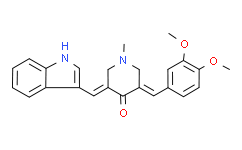| Cas No.: | 1370032-19-1 |
| Chemical Name: | (3E,5E)-3-[(3,4-Dimethoxyphenyl)methylidene]-5-(1H-indol-3-ylmethylidene)-1-methylpiperidin-4-one |
| Synonyms: | CA-5f;BCP30170;(E)-3-((1H-Indol-3-yl)methylene)-5-((E)-3,4-dimethoxybenzylidene)-1-methylpiperidin-4-one;CA 5f;CA5f;(3E,5E)-3-(3,4-dimethoxybenzylidene)-5-[(1H-indol-3-yl)methylene]-1-methylpiperidin-4-one;(3E,5E)-3-[(3,4-Dimethoxyphenyl)methylidene]-5-(1H-indol-3-ylmethylidene)-1-methylpiperidin-4-one |
| SMILES: | O=C1/C(=C(\[H])/C2C([H])=C([H])C(=C(C=2[H])OC([H])([H])[H])OC([H])([H])[H])/C([H])([H])N(C([H])([H])[H])C([H])([H])/C/1=C(/[H])\C1=C([H])N([H])C2=C([H])C([H])=C([H])C([H])=C12 |
| Formula: | C24H24N2O3 |
| M.Wt: | 388.4590 |
| Purity: | >98% |
| Sotrage: | 2 years -20°C Powder, 2 weeks 4°C in DMSO, 6 months -80°C in DMSO |
| Description: | CA-5f is a potent late-stage macroautophagy/autophagy inhibitor via inhibiting autophagosome-lysosome fusion. CA-5f increases LC3B-II (a marker to monitor autophagy) and SQSTM1 protein both in A549 cells and HUVECs. Anti-tumor activity[1]. |
| In Vivo: | CA-5f (40 mg/kg, i.p., every 2 days for up to 30 days) is well tolerated, and potently inhibits the growth of tumor in nude mice bearing A549 lung cancer cells[1]. CA-5f (40 mg/kg, i.p.) suppresses autophagic flux and induces apoptosis in nude mice bearing A549 lung cancer cells[1]. Animal Model: Nude mice bearing A549 lung cancer cells[1] Dosage: 40 mg/kg Administration: Injected via caudal vein, every 2 days for up to 30 days Result: Significantly suppressed tumor volume and weight in mice, increased the number of apoptotic cells in mice. |
| In Vitro: | CA-5f (0-40 μM, 6 hour) concentration- and time-dependently elevates the level of LC3B-II (a marker to monitor autophagy) and SQSTM1 protein both in A549 cells and HUVECs[1]. CA-5f (20 μM, 6 hours) inhibits the degradation of autophagosomes when treated alone or in combination Bafilomycin A1 (100 nM) or Chloroquine (30 μM) in A549 cells and HUVECs[1]. CA-5f (20 μM) neither impairs the hydrolytic function nor the quantity of lysosomes[1]. CA-5f (20 μM, 96 hours) inhibits the growth of A549 cells, and less cytotoxic to normal HUVECs[1]. Cell Viability Assay[1] Cell Line: A549, HUVECs Concentration: 20 μM Incubation Time: 96 hours Result: Exhibited more cytotoxicity against A549 cells compared with normal HUVECs. Western Blot Analysis[1] Cell Line: A549 cells and HUVECs Concentration: 0-40 μM Incubation Time: 6 hours Result: Elevated LC3B-II (a marker to monitor autophagy) and SQSTM1 protein levels in a concentration- and time-dependent manner. |
| References: | [1]. Zhang L, et al. Identification of compound CA-5f as a novel late-stage autophagy inhibitor with potent anti-tumor effect against non-small cell lung cancer. Autophagy. 2019 Mar;15(3):391-406. |

 DC Chemicals' products qualify for U.S. tariff exemptions. We guarantee no price increases due to customs duties and maintain stable supply, continuing to deliver reliable research solutions to our American clients.
DC Chemicals' products qualify for U.S. tariff exemptions. We guarantee no price increases due to customs duties and maintain stable supply, continuing to deliver reliable research solutions to our American clients.





















